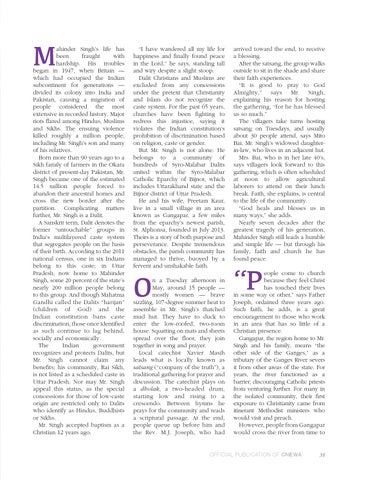M
ahinder Singh’s life has been fraught with hardship. His troubles began in 1947, when Britain — which had occupied the Indian subcontinent for generations — divided its colony into India and Pakistan, causing a migration of people considered the most extensive in recorded history. Major riots flared among Hindus, Muslims and Sikhs. The ensuing violence killed roughly a million people, including Mr. Singh’s son and many of his relatives. Born more than 90 years ago to a Sikh family of farmers in the Okara district of present-day Pakistan, Mr. Singh became one of the estimated 14.5 million people forced to abandon their ancestral homes and cross the new border after the partition. Complicating matters further, Mr. Singh is a Dalit. A Sanskrit term, Dalit denotes the former “untouchable” groups in India’s multilayered caste system that segregates people on the basis of their birth. According to the 2011 national census, one in six Indians belong to this caste; in Uttar Pradesh, now home to Mahinder Singh, some 20 percent of the state’s nearly 200 million people belong to this group. And though Mahatma Gandhi called the Dalits “harijan” (children of God) and the Indian constitution bans caste discrimination, those once identified as such continue to lag behind, socially and economically. The Indian government recognizes and protects Dalits, but Mr. Singh cannot claim any benefits; his community, Rai Sikh, is not listed as a scheduled caste in Uttar Pradesh. Nor may Mr. Singh appeal this status, as the special concessions for those of low-caste origin are restricted only to Dalits who identify as Hindus, Buddhists or Sikhs. Mr. Singh accepted baptism as a Christian 12 years ago.
“I have wandered all my life for happiness and finally found peace in the Lord,” he says, standing tall and wiry despite a slight stoop. Dalit Christians and Muslims are excluded from any concessions under the pretext that Christianity and Islam do not recognize the caste system. For the past 65 years, churches have been fighting to redress this injustice, saying it violates the Indian constitution’s prohibition of discrimination based on religion, caste or gender. But Mr. Singh is not alone. He belongs to a community of hundreds of Syro-Malabar Dalits united within the Syro-Malabar Catholic Eparchy of Bijnor, which includes Uttarakhand state and the Bijnor district of Uttar Pradesh. He and his wife, Preetam Kaur, live in a small village in an area known as Gangapar, a few miles from the eparchy’s newest parish, St. Alphonsa, founded in July 2013. Theirs is a story of both purpose and perseverance. Despite tremendous obstacles, the parish community has managed to thrive, buoyed by a fervent and unshakable faith.
arrived toward the end, to receive a blessing. After the satsang, the group walks outside to sit in the shade and share their faith experiences. “It is good to pray to God Almighty,” says Mr. Singh, explaining his reason for hosting the gathering, “for he has blessed us so much.” The villagers take turns hosting satsang on Tuesdays, and usually about 30 people attend, says Mito Bai, Mr. Singh’s widowed daughterin-law, who lives in an adjacent hut. Mrs. Bai, who is in her late 40’s, says villagers look forward to this gathering, which is often scheduled at noon to allow agricultural laborers to attend on their lunch break. Faith, she explains, is central to the life of the community. “God heals and blesses us in many ways,” she adds. Nearly seven decades after the greatest tragedy of his generation, Mahinder Singh still leads a humble and simple life — but through his family, faith and church he has found peace.
O
eople come to church because they feel Christ has touched their lives in some way or other,” says Father Joseph, ordained three years ago. Such faith, he adds, is a great encouragement to those who work in an area that has so little of a Christian presence. Gangapar, the region home to Mr. Singh and his family, means “the other side of the Ganges,” as a tributary of the Ganges River severs it from other areas of the state. For years, the river functioned as a barrier, discouraging Catholic priests from venturing further. For many in the isolated community, their first exposure to Christianity came from itinerant Methodist ministers who would visit and preach. However, people from Gangapar would cross the river from time to
n a Tuesday afternoon in May, around 15 people — mostly women — brave sizzling, 107-degree summer heat to assemble in Mr. Singh’s thatched mud hut. They have to duck to enter the low-roofed, two-room house. Squatting on mats and sheets spread over the floor, they join together in song and prayer. Local catechist Xavier Masih leads what is locally known as satsang (“company of the truth”), a traditional gathering for prayer and discussion. The catechist plays on a dholak, a two-headed drum, starting low and rising to a crescendo. Between hymns he prays for the community and reads a scriptural passage. At the end, people queue up before him and the Rev. M.J. Joseph, who had
“P
OFFICIAL PUBLICATION OF CNEWA
31
